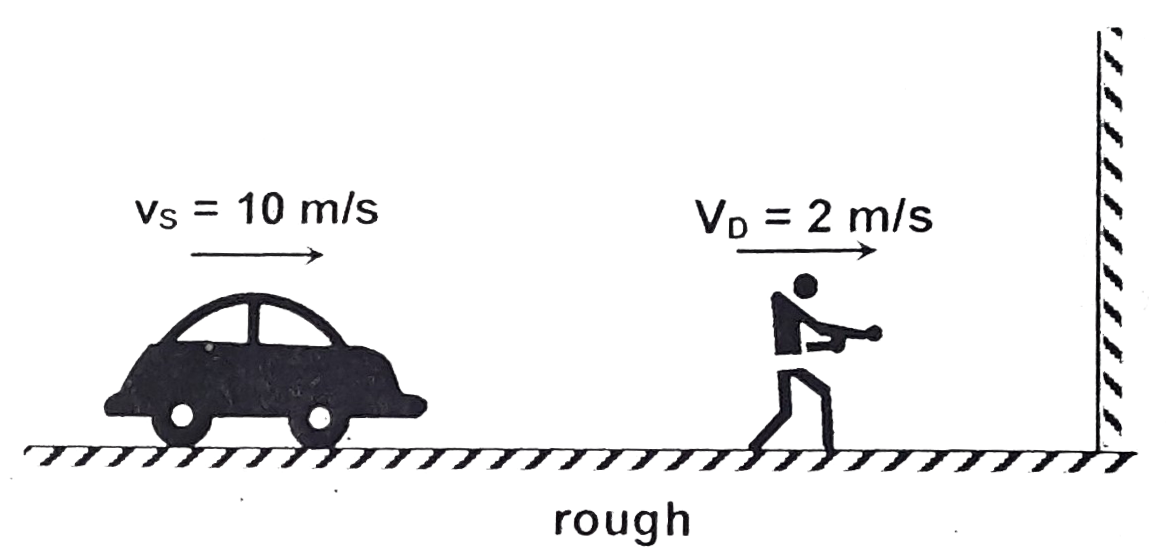A car moving with a velocity of 10m/s can be stopped by the application of a constant force F In a distance of 20m. If the velocity of the car is 30m/s. It can be stopped by this force in
203m
20 m
60 m
180 m
The correct Answer is:D
To solve the problem, we will use the equations of motion. The key equation we will use is:
v2=u2+2as
where:
- v is the final velocity,
- u is the initial velocity,
- a is the acceleration (or deceleration in this case), and
- s is the distance.
Step 1: Determine the deceleration when the car is moving at 10 m/s.
Given:
- Initial velocity u=10m/s
- Final velocity v=0m/s (since the car stops)
- Distance s=20m
Using the equation of motion:
0=(10)2+2a(20)
This simplifies to:
0=100+40a
Rearranging gives:
40a=−100⟹a=−10040=−2.5m/s2
Step 2: Use the deceleration to find the stopping distance when the car is moving at 30 m/s.
Now, we need to find the stopping distance when the initial velocity u=30m/s and the same deceleration a=−2.5m/s2.
Using the same equation of motion:
0=(30)2+2(−2.5)s
This simplifies to:
0=900−5s
Rearranging gives:
5s=900⟹s=9005=180m
Final Answer:
The car can be stopped by the same force in a distance of 180 meters.
---
- v is the final velocity,
- u is the initial velocity,
- a is the acceleration (or deceleration in this case), and
- s is the distance.
- Initial velocity u=10m/s
- Final velocity v=0m/s (since the car stops)
- Distance s=20m
The car can be stopped by the same force in a distance of 180 meters.
Topper's Solved these Questions
- BOOK - DC PANDEY ENGLISHCHAPTER - MOTION IN A PLANEEXERCISE - (B) Meical entrance special format questions (Assertion and reason)19videos
MOTION IN A PLANE
- BOOK - DC PANDEY ENGLISHCHAPTER - MOTION IN A PLANEEXERCISE - (B) Meical entrance special format questions (Mathch the columns)6videos
MOTION IN A PLANE
- BOOK - DC PANDEY ENGLISHCHAPTER - MOTION IN A PLANEEXERCISE - Check point 3.715videos
MOTION IN A PLANE
- BOOK - DC PANDEY ENGLISHCHAPTER - MOTIONEXERCISE - Medical entrances gallery19videos
MOTION
- BOOK - DC PANDEY ENGLISHCHAPTER - PROJECTILE MOTIONEXERCISE - Level - 2 Subjective10videos
PROJECTILE MOTION
Similar Questions
A car moving with a velocity of 40 km/h can be stopped by brekes after travelling at least 5 m. If same car moves at a speed of 80 km/h the minimum stopping distance is
View SolutionA car is moving with velocity V. If stop after applying break at a distance of 20 m. If velocity of car is doubled, then how much distance it will cover (travel) after applying break :
View Solution
Knowledge Check
- Question 1 - Select One
A car, moving with a speed of 50km/hr, can be stopped by brakes after at least 6m. If the same car is moving at a speed of 100km/hr, the minimum stopping distance is
A6 mB12 mC18 mD24 m
A car moving with a speed of 40km/h can be stopped by applying the brakes after at least 2 m. If the same car is moving with a speed of 80km/h, what is the minimum stopping distance?
View SolutionA car moving with a speed of 40km/h can be stopped by applying the brakes after at least 2 m. If the same car is moving with a speed of 80km/h, what is the minimum stopping distance?
View SolutionA cart is moving with a velocity 20m/s. Sand is being dropped into the cart at the rate of 50 kg/min. The force required to move the cart with constant velocity will be :-
View SolutionA car is moving with a constant velocity 10m/s towards the stationary wall. The car blows a horn of frequency 320Hz. The velocity of sound in air is 330m/s. The beats frequency received by the observer is
 View Solution
View SolutionA car is moving with a velocity 20m s−1. The brakes are applied to retard it at a rate of 2m s2. What will be the velocity after 5 s of applying the brakes?
View SolutionA body of mass 14kg moving with velocity 12m/s is stopped by applying a force of 0.6 N. Then impulse is :-
View SolutionA ball of mass 0.2 kg moves with a velocity of 20m/sec and it stops in 0.1 sec , then the force on the ball is
View Solution
